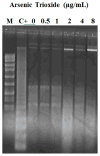Therapeutic Potential of Arsenic Trioxide (ATO) in Treatment of Hepatocellular Carcinoma: Role of Oxidative Stress in ATO-Induced Apoptosis
- PMID: 29214213
- PMCID: PMC5713642
Therapeutic Potential of Arsenic Trioxide (ATO) in Treatment of Hepatocellular Carcinoma: Role of Oxidative Stress in ATO-Induced Apoptosis
Abstract
Hepatocellular carcinoma (HCC), the dominant form of primary liver cancer, is the sixth most common cancer in the world with more than 700,000 people diagnosed annually. Arsenic trioxide (ATO) has been shown to be a potent anticancer agent in various carcinomas, proving particularly effective in the clinical treatment of relapsed and refractory acute promyelocytic leukemia. However, its bioactivity and molecular mechanisms against HCC has not been fully studied. Using human HCC (HepG2) cells as a test model, we studied the effects of ATO and examined the role of oxidative stress (OS) and apoptosis in cytotoxicity. OS biomarkers showed a significant increase (p< 0.05) of malondialdehyde concentrations, and a gradual decrease of antioxidant enzymes (GPx & CAT) activities with increasing ATO doses. Flow cytometry data showed a dose dependent increase in annex in V positive cells and caspase 3 activities. These results were confirmed by data of the DNA laddering assay showing a clear evidence of nucleosomal DNA fragmentation, as well as data from Western blotting showing a significant modulation of specific apoptotic related proteins, including the activation of p53 and p21 expression and the down-regulation of Bcl-2 expression in ATO-treated cells. Taken together, our research demonstrates that ATO has a potential therapeutic effect against HCC, and its cytotoxicity may be mediated via oxidative stress and activation of the mitochondrial or intrinsic pathway of apoptosis.
Keywords: ATO; Apoptosis; DNA fragmentation; HepG2 cells; Oxidative stress.
Figures














Similar articles
-
Evaluation of Arsenic Trioxide Potential for Lung Cancer Treatment: Assessment of Apoptotic Mechanisms and Oxidative Damage.J Cancer Sci Ther. 2016 Jan;8(1):1-9. doi: 10.4172/1948-5956.1000379. Epub 2015 Dec 18. J Cancer Sci Ther. 2016. PMID: 27158419 Free PMC article.
-
Vitamin D3 potentiates the antitumorigenic effects of arsenic trioxide in human leukemia (HL-60) cells.Exp Hematol Oncol. 2014 Mar 25;3(1):9. doi: 10.1186/2162-3619-3-9. Exp Hematol Oncol. 2014. PMID: 24661615 Free PMC article.
-
Suppression of TG-interacting factor sensitizes arsenic trioxide-induced apoptosis in human hepatocellular carcinoma cells.Biochem J. 2011 Sep 1;438(2):349-58. doi: 10.1042/BJ20101653. Biochem J. 2011. PMID: 21649584
-
Arsenic Trioxide Induces Apoptosis via Specific Signaling Pathways in HT-29 Colon Cancer Cells.J Cancer Sci Ther. 2017 Jan;9(1):298-306. Epub 2016 Jan 9. J Cancer Sci Ther. 2017. PMID: 28966729 Free PMC article.
-
Shikonin potentiates the effect of arsenic trioxide against human hepatocellular carcinoma in vitro and in vivo.Oncotarget. 2016 Oct 25;7(43):70504-70515. doi: 10.18632/oncotarget.12041. Oncotarget. 2016. PMID: 27655700 Free PMC article.
Cited by
-
Effect of lycopene on As2O3 induced oxidative stress in SH-SY5Y cells.Mol Biol Rep. 2021 Apr;48(4):3205-3212. doi: 10.1007/s11033-021-06377-y. Epub 2021 May 4. Mol Biol Rep. 2021. PMID: 33948854
-
Therapeutic Mechanisms of Vernonia amygdalina Delile in the Treatment of Prostate Cancer.Molecules. 2017 Sep 22;22(10):1594. doi: 10.3390/molecules22101594. Molecules. 2017. PMID: 28937624 Free PMC article.
-
The anti-inflammatory effect of arsenic trioxide effectively mitigates the pathogenic process in local chickens with avian leukosis.Poult Sci. 2024 Dec;103(12):104288. doi: 10.1016/j.psj.2024.104288. Epub 2024 Sep 7. Poult Sci. 2024. PMID: 39353327 Free PMC article.
-
Exploration of the hepatoprotective effect and mechanism of magnesium isoglycyrrhizinate in mice with arsenic trioxide‑induced acute liver injury.Mol Med Rep. 2021 Jun;23(6):438. doi: 10.3892/mmr.2021.12077. Epub 2021 Apr 13. Mol Med Rep. 2021. PMID: 33846815 Free PMC article.
-
A prospective trial to evaluate the clinical efficacy and safety of neoadjuvant chemotherapy with arsenic trioxide and carboplatin in locally advanced cervical cancer: a study protocol for randomized controlled clinical.Trials. 2022 Jul 8;23(1):556. doi: 10.1186/s13063-022-06489-1. Trials. 2022. PMID: 35804452 Free PMC article.
References
-
- Torre LA, Bray F, Siegel RL, Ferlay J, Lortet-Tieulent J, Jemal A. Global cancer statistics. CA Cancer J Clin. 2015;65:87–108. - PubMed
-
- Jemal A, Bray F, Center MM, Ferlay J, Ward E, Forman D. Global cancer statistics. CA Cancer J Clin. 2011;61:69–90. - PubMed
-
- American Cancer Society. Cancer Facts & Figures 2016. Atlanta, Ga: American Cancer Society; 2016.
-
- U.S. Cancer Statistics Working Group. United States Cancer Statistics: 1999–2012 Incidence and Mortality Web-based Report. Atlanta: U.S. Department of Health and Human Services, Centers for Disease Control and Prevention and National Cancer Institute;
Grants and funding
LinkOut - more resources
Full Text Sources
Research Materials
Miscellaneous
